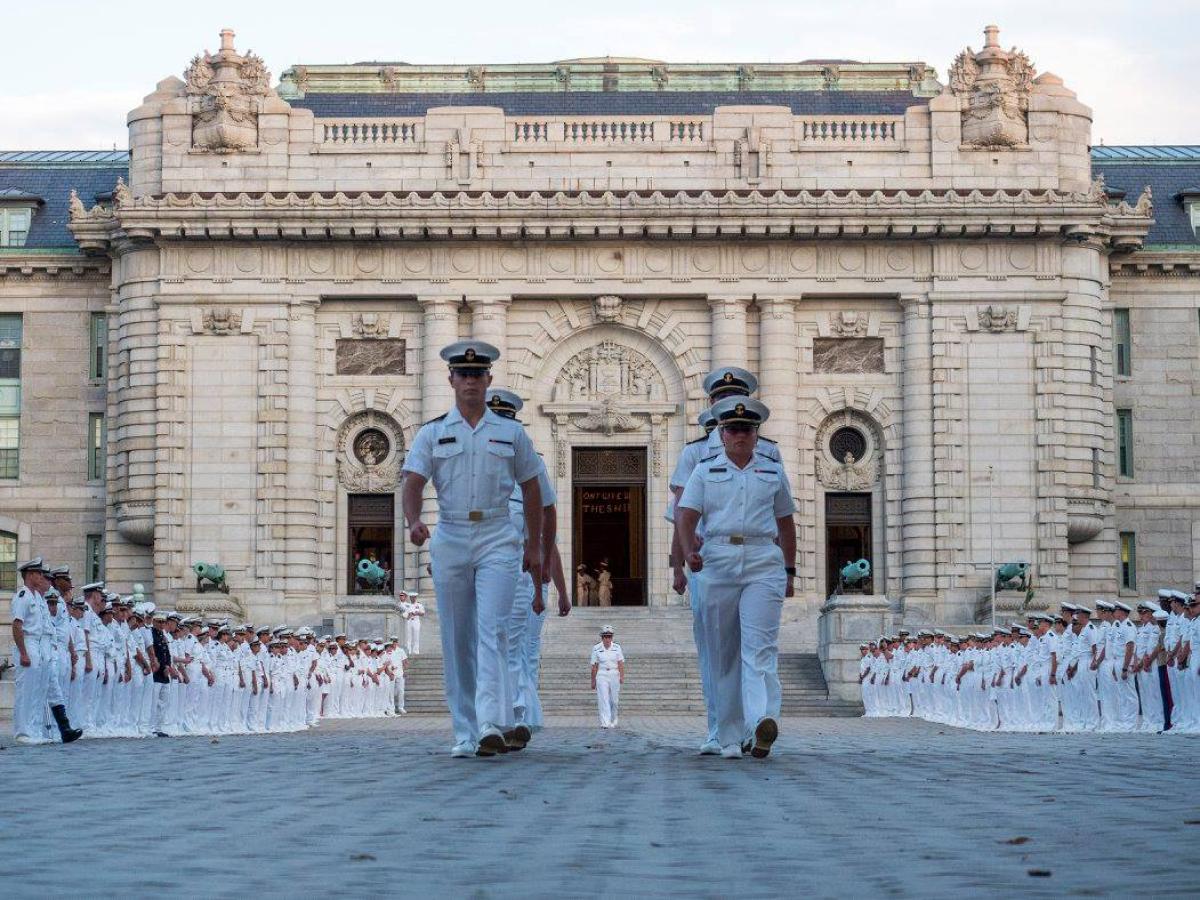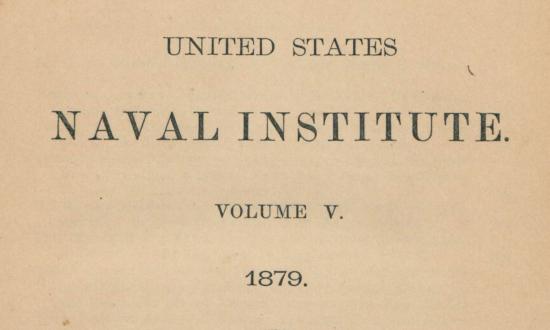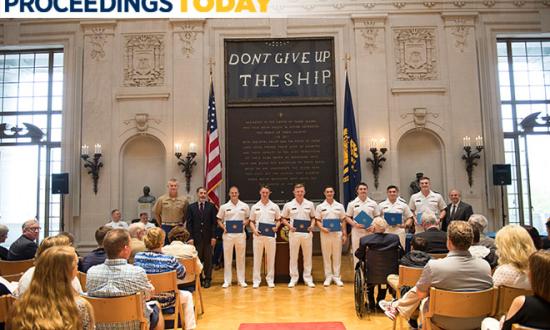As the U.S. Naval Academy sails further into the 21st century, faculty remain alert to developments in the world around us. The return of war to Europe, the emergence of China as a global competitor and pacing threat, the ongoing national controversy over what is taught as American history, and the 50th anniversary of the introduction of academic majors at the Naval Academy, make this an excellent time to review why history remains a critical part of a Naval Academy education.
The Chief of Naval Operations’ recent Get Real, Get Better initiative as well as the emphasis on “intellectual readiness” in the U.S. Naval Institute’s American Sea Power Project underscore this urgency. As history faculty, our view is straightforward: Effective leadership requires applied history. We cannot accurately understand the world today without knowing how it got that way—which is to say, through history, the discipline that explains how everything in the world came to be the way that it is. In the real world, everything—politics, economics, religion, etc.—is connected to everything else. This is the context in which leaders decide and act. And the skills of evidence-based analysis, conclusion, and communication learned in history classrooms remain central to how today’s officers approach the challenges and gray areas of the real world. As an all-encompassing and an integrating discipline, history is a capstone discipline for leaders.
Teaching and Learning the Past
Humans make the future, and with it they make history. Effective leaders master the past to more effectively shape the future. People who do not know the past are lost in the present. Lost leaders are a danger to the people they lead. Lost citizens are a danger to themselves and to their fellow citizens. We teach midshipmen history because there is no better preparation for leadership. The mission of the Naval Academy History Department is to ensure graduates understand their past so they can be effective leaders in the future—first as officers, but, ultimately, as citizen-leaders meeting the challenging responsibilities we teach them to embrace as their life’s work.
Learning history equips students with a particular set of intellectual skills and orientations necessary not just for a strong understanding of the past, but also for effective present-day action. It teaches careful respect for evidence, critical thinking and analysis skills, and how to form sound conclusions in contexts characterized by complexity, ambiguity, and incomplete information. It cultivates the development of informed judgment, clearly expressed. History also teaches us to be skeptical of first reports, reductive explanations, and single-perspective narratives. It encourages the habit of asking questions, pursuing answers, and analyzing experiences from various points of view. In other words, history is the discipline that best teaches analysis and conclusion the way that leaders must do it in the real world if they are to be effective.
Midshipmen commission into warfighting communities in the Navy and Marine Corps. They lead diverse teams of sailors and Marines and deploy to parts of the world far from the United States. Therefore, the History Department serves the Naval Academy mission by aiming to excel in three areas—naval and military history, the history of the world’s most important regions, and the history of human differences. Every midshipman, regardless of their major, spends three semesters in history classrooms acquiring a broad foundation in history focused in these areas.
The Work of the Academy’s History Department
Seventy percent of the History Department’s teaching is done in courses that all midshipmen are required to take in their 31-course core curriculum. The history core courses—American Naval History (HH104) and a two-semester world history sequence, The West/Middle East/Asia in the Premodern World (HH215x) and The West in the Modern World (HH216)—are the minimum number of courses necessary for the leadership proficiency expected of junior officers in the naval service. The importance of naval history and world history in the general education of our students is self-evident. Midshipmen need to know the history of the U.S. Navy and Marine Corps. They need to know the deeper histories of the cultures and religions that still animate important regions of the world today (i.e., Greek/Roman, Judeo-Christian, Islamic, Hindu, Buddhist, Confucian). They need to know about the emergence of modern democracy and the continuing appeal of authoritarian forms of government, nation states and great power rivalry, an industrialized global economy, and the origins, persistence, and fallacies of modern racism.
The History Core constitutes an integrated whole in which the total educational impact is greater than the sum of the individual courses. The three courses share the same larger themes, develop a common set of leadership-essential history-specific skills, and have a three-course assessment methodology that measures student acquisition of skills and knowledge across the sequence and provides us with the data for continual improvement. The core courses necessarily differ in historical content, but they all explore four broad themes essential to the leadership preparation of midshipmen:
- Global Perspectives
- Sea Power
- War and Society
- Human Differences
As plebes, all midshipmen take American Naval History (HH104)—the primary means to accomplish one of the Academy’s 2030 Strategic Plan’s chief goals: Imparting an indelible sense of naval heritage to our students. We do this by teaching the history of the U.S. Navy and the U.S. Marine Corps. While students certainly take inspiration from this course, they learn the actual history as opposed to the mythology—the unrelenting challenge of adaptive leadership as Navy and Marine Corps leaders made decisions with limited resources about better organizing sailors and Marines and choosing new weapon systems ahead of and during tests of conflict.
The hardest and most consequential decisions often were made in peacetime missions of naval diplomacy, the protection of American interests, and in preparation for war. The course explores the challenges and successes in creating effective teams from diverse sailors and Marines. It focuses on the rise of American sea power and the projection of American influence beyond the continental United States in rivalry with other sea powers—Britain and France, Germany and Japan, the Soviet Union and China. It traces the development, setbacks, and successes of the Navy and Marine Corps in conflicts from the American Revolution to Iraq and Afghanistan.
In their second year, midshipmen take a two-semester, two-course world history sequence. The first half of this sequence covers premodern history—roughly the world before 1700. Students select one of the three versions of this course: The West in the Premodern World (HH215), Asia in the Premodern World (HH215A), or The Middle East in the Premodern World. (HH215M). All three cover world history, but with a different predominant geographic and cultural focus.
Students learn the premodern events, some that go back thousands of years, that shaped and continue to shape the everyday lives, worldviews, policies, and self-conceptions of modern nations. They learn how complex agrarian societies developed, how the rulers and peoples of these societies organized to better protect themselves from their neighbors, and how innovations in the arts of war and governance enabled them to conquer and rule others. They learn belief systems, ethical perspectives, and worldviews very different from their own.
By studying the origins of world religions such as Judeo-Christianity, Islam, Buddhism, and Hinduism, and ethical systems such as Confucianism and Greek and Roman philosophy, midshipmen are better prepared to understand the potency of these beliefs in the contemporary world. Midshipmen learn about the importance of the Mediterranean, the Indian Ocean, the South China Sea, and the Atlantic and Caribbean, and the great seafaring peoples—Greeks, Arabs, Vikings, and the Ming China fleets of Zheng He, as well as the European mariners who developed the nautical skills to sail anywhere on the planet and return home. Thus, midshipmen learn the premodern roots of globalization, and the context that gave rise to modern capitalism, colonialism, and Atlantic slavery.
In the second part of the world history sequence, The West in the Modern World (HH216), midshipmen focus on the two great developments of the past 250 years: An economic revolution based on markets, technological innovation, and international trade, which raised material standards of living for billions; and the emergence of democratic systems of governance, and the ensuing debate that continues today over the effectiveness of democratic and authoritarian forms of government. These twin developments were central to 20th-century history, evident in the Great Depression, the World Wars, and the Cold War, as communists, fascists, and liberal democrats experimented, argued, and fought with one another over which political and economic systems best furthered human welfare.
The course focuses on the emergence of nation states and nationalism as well as great power rivalry on land, sea, air, and space. It explains the rise and decline of European power, the rise of the United States, the birth of new states after European colonial rule, and the fall and sudden dramatic return of China to world power. It also covers the end of slavery, the emergence of pseudo-scientific racist ideologies that led to Jim Crow and the Holocaust, and the humanitarian and human rights revolutions that have struggled with some success against the pernicious historical legacies of bias to raise the dignity of all people.
Both HH104 and HH216 contain a substantial amount of U.S. history, building on the foundations of U.S. history in premodern history. U.S. history and world history traditionally were taught separately in undergraduate history programs. The integration of U.S. history into world history is now best-practice in our field, but for midshipmen it is vital to their understanding of their role as future representatives of the nation within the wider world. At the Naval Academy, we have been teaching U.S. history as part of world history for 40 years.
There is no single master syllabus for any of these three courses. Our instructors work within this general framework. All three courses require healthy amounts of reading and writing. There is no body of professional knowledge that can be mastered without reading and a deeper comprehension of what we have read. Midshipmen and effective leaders must also clearly communicate their conclusions. In every history core course, midshipmen are required to produce critical analyses of sources, argumentative essays based on evidence, or longer research papers. HH104 is often the first college writing course that midshipmen take, and HH216 for our STEM majors is usually the last required humanities course that provides close attention to writing. Midshipmen move through the history course sequence to develop their research and analytical skills, while working to make their expository writing fleet-ready.
In addition to the three core courses, the History Department offers a variety of electives open to history majors and the Brigade at large. Every doctorate-holder in the department offers upper-level elective courses in their specialties, 20 or more different courses each semester in naval/military history, American history, European history, and the histories of the world’s other strategic regions, as well as courses oriented around themes that cut across times and places. We teach history as accurately as our discipline permits, without fear or favor, and let the chips fall where they may.
History, Not Politics
Teaching such a broad curriculum requires academic freedom, which we have because the Naval Academy subscribes to the same principles to which nearly all U.S. institutions of higher education subscribe. Some in the larger public seem to believe—or insinuate for their own purposes—that teaching history is a form of political indoctrination. Our faculty have a diversity of personal views, but these are checked at the classroom door. We do not “cherry-pick” history for “facts” to support contemporary viewpoints—that is bad history, and we do not teach bad history. Moreover, midshipmen are not that gullible. They demand the complete picture. In our classrooms we work hard together to ensure that this happens.
We don’t kid ourselves. The Naval Academy History Core is a good start. A history major on top of the core courses is an even better start. But both are just solid foundations on which to build. For the study of history to create effective leaders, leaders must be lifelong students of history. No goal is more important to us than creating as many lifelong learners as possible among Naval Academy graduates. Lifelong students of history acquire not only an ever-growing body of knowledge about how the world came to be but hone the habits of mind essential to the effective leader. Complexity challenges and often frustrates us. History teaches us to respect that reality, to accept that we cannot simplify complexity, or, if we want to be effective leaders, walk away from it, but that we must persevere with complexity as an inescapable part of past and present reality.
The more we learn, the more we realize how little we know. Armed with knowledge and skill, we still confront a present and future that we see and understand imperfectly, and that we cannot completely control. History in this way teaches us humility. The historian must work as hard as possible to know as much as possible, while remaining humble. The same is true for military officers. The best way to ensure intellectual readiness for anything is to be alert and thoughtful—keep reading, observing, thinking, and learning.
Finally, history teaches courage. Not just the battlefield courage that history has traditionally heralded, nor even the moral courage we learn from great figures such as Gandhi and Martin Luther King, Jr., but the courage to see action all the way through to achievement. This is what President John F. Kennedy meant when he said, “We choose to go to the Moon…, and do the other things, not because they are easy, but because they are hard.” He led a nation that had the courage to achieve.
As important as the first two kinds of courage are to military officers, the third is equally important and the most likely to be forgotten, especially among people and nations long accustomed to superiority. Militaries exist to win wars. The courage to achieve has a lot to do with the undaunted, unbreakable will to win. We can play around with platitudes, but the fact is that the American people expect us to teach Naval Academy students the history they need to know to defend the nation. Are we doing this? We ask this question every day and try every day to answer it to the very best of our ability. We welcome the challenge.






